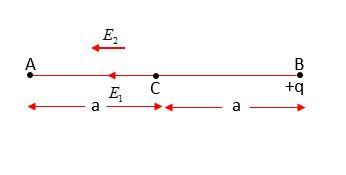
Define electric field intensity. Write its $SI$unit. Write the magnitude and direction of electric field intensity due to a dipole of length $2a$at the midnight of the line joining the two charges.
Answer
555.9k+ views
Hint: The electric field is a region around a charge in which it exerts an electrostatic force on other charges. While the strength of the electric field at any point in space is called electric field intensity. It is a vector quantity.
Complete step by step answer:

Electric field intensity: the electric intensity at any point in an electric field is defined as the electric force per unit positive test charge placed at that point i.e.
$\vec E = \mathop {\lim }\limits_{{q^{ \to 0}}} \dfrac{{\vec F}}{{{q_0}}}$
The test charges ${q_0}$has to be vanishingly small so that it does not affect the electric field of the main charge.
The $SI$ unit of electric field intensity is newton/coulomb.
Electric field strength at midpoint of dipole: the electric field strength at midpoint $C$due to charge $ + q$is $ - q$along the same direction.
$E = {E_1} + {E_2} = \dfrac{1}{{4\pi { \in _0}}}\dfrac{q}{{{a^2}}} + \dfrac{1}{{4\pi { \in _0}}}\dfrac{q}{{{a^2}}} $
$= \dfrac{1}{{4\pi { \in _0}}}\dfrac{{2q}}{{{a^2}}}$
Its direction is from $ + q$to $ - q$.
Note:
A measure of the force exerted by one charged body on another. The electric field intensity (volts/meter) at any location is the force (Newtons) that would be experienced by unit test charge placed at the location. Electric field is the negative gradient of the scalar potential. The negative sign came as a result because the potential difference is the work done per unit charge against the electrostatic force to move a charge from $a$to $b$. The electric field intensity at any point due to a system or group of charges is equal to the vector sum of electric field intensities due to individual charges at the same point.
Complete step by step answer:

Electric field intensity: the electric intensity at any point in an electric field is defined as the electric force per unit positive test charge placed at that point i.e.
$\vec E = \mathop {\lim }\limits_{{q^{ \to 0}}} \dfrac{{\vec F}}{{{q_0}}}$
The test charges ${q_0}$has to be vanishingly small so that it does not affect the electric field of the main charge.
The $SI$ unit of electric field intensity is newton/coulomb.
Electric field strength at midpoint of dipole: the electric field strength at midpoint $C$due to charge $ + q$is $ - q$along the same direction.
$E = {E_1} + {E_2} = \dfrac{1}{{4\pi { \in _0}}}\dfrac{q}{{{a^2}}} + \dfrac{1}{{4\pi { \in _0}}}\dfrac{q}{{{a^2}}} $
$= \dfrac{1}{{4\pi { \in _0}}}\dfrac{{2q}}{{{a^2}}}$
Its direction is from $ + q$to $ - q$.
Note:
A measure of the force exerted by one charged body on another. The electric field intensity (volts/meter) at any location is the force (Newtons) that would be experienced by unit test charge placed at the location. Electric field is the negative gradient of the scalar potential. The negative sign came as a result because the potential difference is the work done per unit charge against the electrostatic force to move a charge from $a$to $b$. The electric field intensity at any point due to a system or group of charges is equal to the vector sum of electric field intensities due to individual charges at the same point.
Recently Updated Pages
A man running at a speed 5 ms is viewed in the side class 12 physics CBSE

The number of solutions in x in 02pi for which sqrt class 12 maths CBSE

State and explain Hardy Weinbergs Principle class 12 biology CBSE

Write any two methods of preparation of phenol Give class 12 chemistry CBSE

Which of the following statements is wrong a Amnion class 12 biology CBSE

Differentiate between action potential and resting class 12 biology CBSE

Trending doubts
What are the major means of transport Explain each class 12 social science CBSE

Which are the Top 10 Largest Countries of the World?

Draw a labelled sketch of the human eye class 12 physics CBSE

Explain sex determination in humans with line diag class 12 biology CBSE

Explain sex determination in humans with the help of class 12 biology CBSE

Differentiate between homogeneous and heterogeneous class 12 chemistry CBSE




